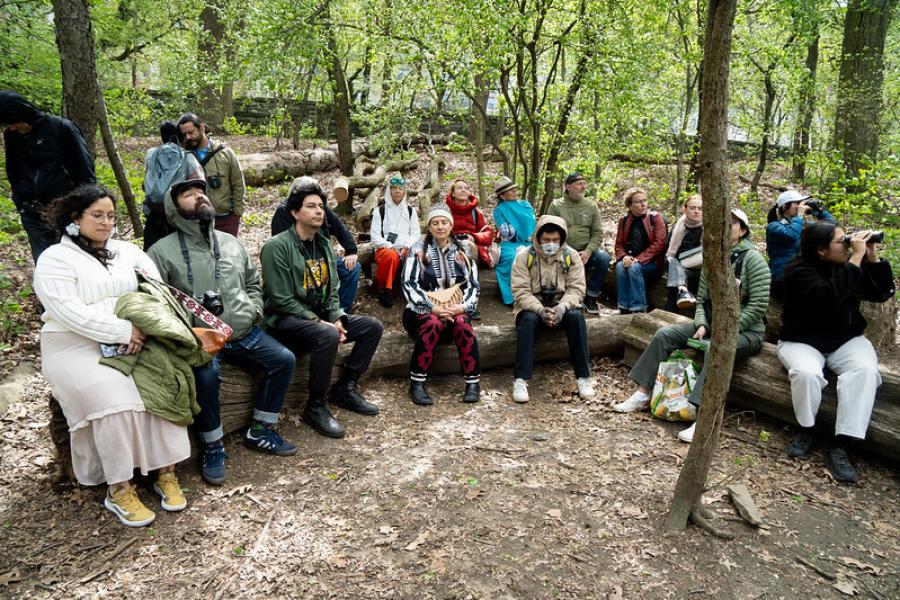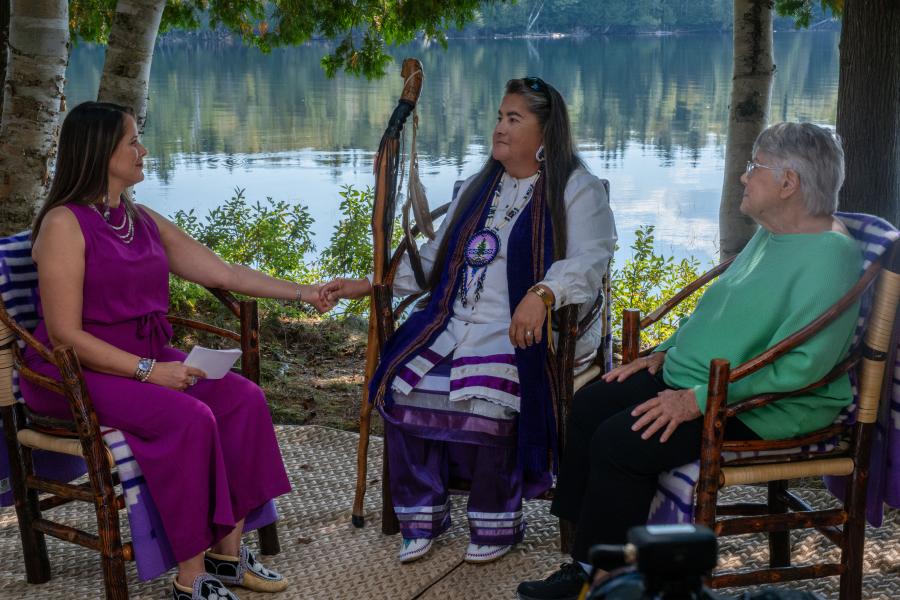As stated by Lenny Foster, Director of the Navajo Nation Corrections, "The Paramount Native American human rights problem in American prisons today is the denial of their right to practice tribal religion."
In recent months, Indian country has become increasingly concerned with this issue. Organizations such as the National Congress of American Indians (NCAI) have issued resolutions addressing the growing infringements upon the religious liberty of Native prisoners. In addition, a group named the national Native American Prisoners' Rights Advocates Coalition (NNAPRAC) has recently been formed to request that the U.S. Attorney General take affirmative action to protect the free exercise of religion by Native American prisoners. Whether efforts of this nature will be successful in the United States remains to be seen, given the pending legislation in the present Congress toward restricting the legal rights of prisoners and their ability to seek protection in the federal courts. Reality versus Image
Imprisonment is familiar way of life for large numbers of native Americans. Sadly, most Native people have either known life as an incarcerated prisoner or have a close family member who is imprisoned presently or has been imprisoned in the past.
This institutionalization of Native American contrasts sharply with the characteristic image of Indian life, which prevails in other countries, that Native Americans live close to nature and embody freedom, liberty and individuality. Indeed, early European thinkers who lived under Old World monarchies, oligarchies and aristocracies were greatly impressed by the Indians' love of freedom, individuality and equality which was deeply ingrained in Native America.
In contrast to traditional European ruling bodies, Huron Indian explained his own governance: "Were are born free and united brothers, each as much a great Lord as the other, while you are all the slaves of one sole man. I am the master of my body, I dispose of myself, I do what I wish, I am the first and the last of my Nation...subject only to the Great Spirit" (Weatherford 1988). These notions of freedom, individuality and equality went on to vastly influence 17th and 18th century European philosophy and political thought, leading ultimately to the development of democracy in the United States. (Weatherford 1988).
Today, Native Americans are not "born free" like their ancestors from time immemorial. Certainly, Native people retain their ancient love of freedom. However, they must now defend and protect that freedom in a human rights struggle to maintain traditional relationships to the natural world. Contrary to the romantic and popular image of Indians, they rank among the most highly regulated of institutionalized people in the United States. Because of their unique legal status, Native Americans are subject to a confusing array of overlapping tribal, state, and federal jurisdiction-a complex web of government regulations that pervade most aspects of reservation life.
Government regulation is particularly pronounced in the area of tribal religious in the United States from 1892 until 1934. For example, the time, place and manner of Native access to tribal religious sites located on federal land are regulated by federal agencies. It is far more complicated, difficult and arbitrary for Native Americans to pray than can be imagined by most people who have free, unregulated access to their churches and other places of worship. In addition, the use and possession of sacred objects (such as eagle feathers, peyote and animal parts) by Indian for religious purposes is comprehensively regulated by a host of federal, and sometimes state, laws and regulations. For Indians who are locked away behind prison walls in America's most totalitarian of communities, their practice of religion as a civil liberty is severely restricted and heavily regulated-apparently even more than that of prisoners of other faiths-as shown in the records of many Congressional hearings between 1978-1992. Indians and Prisons
At one time there were no prisons in existence in North America. Prisons originated in the Old World and were exported to the Western Hemisphere by European nations which had long histories of incarcerating large numbers of people.
Many of the first native American experiences with incarceration came when chiefs, warriors, families and sometimes entire tribes were confined as POWs or criminal in the so-called "Indian Wars" in place such as Ft. Marrion in Florida, Ft. Sill in Oklahoma and Bosque Redondo in New Mexico. Upon his surrender and pending incarceration as a POW, one such warrior of the Ho Chunk Nation, Red Bird, stated resignedly in 1827, "I am ready. I do not wish to be put in irons. Let me be free. I have given away my life-it is gone" (Armstrong 1971). Red Bird later died in prison.
For the indigenous people of the Americas, penal institutions were very alien institutions. Imprisonment had never been used to punish people who violated tribal law. For example, on the topic of law a Mohawk Indian leader explained indigenous nations of criminal justice in 1807: "Among us we have no prisons, we have no pompous parade of courts; we have no written laws, and yet judges are as highly revered among us as they are among you, and their decisions are as highly regarded. Property...is well guarded, and crimes are as impartially punished. We have among us no splendid villains above the control of our laws. Daring wickedness is never suffered to triumph over helpless innocence. The estates of windows and orphans are never devoured by enterprising shapers. In a word, we have no robbery under color of law" (Armstrong 1971). Today, disproportionately high numbers of Native American citizens are confined in American prisons. Caused by factors such as alcoholism, poverty, the social anomie of living in two worlds, inadequate legal representation and discrimination in the criminal justice system, the Native American incarceration rate is astounding.
Some of the more dramatic examples are in Hawaii, Alaska, South Dakota and Montana. In these states Indians comprise 34.7%, 31.7%, 24.9% and 15.5%, receptively, of these states' prison populations. However, of the total populations of these states, they only comprise 18.9%, 15.9%, 6.5% and 4.7%, respectively (Simpson 1993).
These incarcerated thousands of native Americans represent important human and cultural resources, irreplaceable to their Tribes and families. When they are released, it is important to the cultural survival of Indian tribes and Native communities that returning offenders be contributing, culturally viable members, rather than further alienated and assimilated by their experience in the White Man's prisons. Therefore, virtually every Native American and Indian Tribe is directly and vitally impacted by prison policies which affect the rights, rehabilitation and well being of these prisoners.
Twenty years ago, little was known about the fact of Native prisoners, and the problems faced by them while imprisoned. Since then, Indian Tribes and native organizations have developed a number of programs to meet the needs of incarcerated Native prisoners and to learn more about the issues and problems confronting them. These efforts included the work of the prison litigation project of the Native American Rights Fund, the Swift Bird Alternative Corrections Center of the Cheyenne River Sioux Tribe, the Navajo Nation Corrections Project and many others. Legislation and Litigation
Today, the long-standing problem of prisoners' religious freedom has bee the subject of over 50 lawsuits since 1972, and several unsuccessful federal legislative efforts in the 103rd Congress. This continuing human rights problem has been fully documented in congressional hearing held in 1978, 1992, 1993 and 1994. In addition, President Carter's administration conducted a 1979 study regarding problems in Native American free religious exercise as required by Section 2 of the American Indian Religious Freedom Act.
Under U.S. law, prison inmates retain their First Amendment rights to the free exercise of religion. Since the founding of prison in the United States, worship and religious instruction has always been viewed as a primary rehabilitation tool to help reform prisoners, restore their values and prepare them to be productive members of society. As stated in the Manual of Correctional Standards of the American Correctional Association (1971): "From its very inception in 1870, the American Correctional Association has recognized and emphasized the role of religion in the correctional process." Thus, in a rare exception to the constitutional prohibition against government entanglement with religion (which is managed by the Establishment Clause of the First Amendment to the U.S. Constitution, prisons freely supply prisoners with access to religion at state expense because of the unique circumstance of citizens being confined in the custody of the state, the need to allow prisoners to practice their religions and the importance of religion in the rehabilitation practice. These laudable goals, of course, are especially important for native American prisoners, because of the paramount important for Native American prisoners, because of the paramount importance of traditional religions in their identity. Tribal religion is the cornerstone of native American culture. native religious beliefs and practices form the glue which has held Indian tribes together over the centuries in the face of great adversity. The protection of this spiritual way of life is, therefore, of vital importance to the cultural survival of Indian Tribes and Native peoples. The Changing Tide in Policy
Unfortunately, to enthocentric American person officials, who cared or knew little about Native religions, "rehabilitation" meant assimilating Native prisoners into mainstream White society by stripping Indians of their cultural identity and instilling Anglo-Christian religions and ethics. Thus, all aspects of Native culture, dress, hairstyle and religious practices were denied in favor of a uniform state regimen to remake Indians into mainstream Americans.
In the 1970s, as the result of voluminous litigation, this practice began to change as prisons began to recognize and permit Native religious practices, such as the wearing of traditional hairstyles, use and possession of sacred object, access to traditional religious leaders and to ceremonial facilities such as the sweat lodge (a small, domeshaped structure made with willows and covered in blankets, similar in function to a sauna, and used for thousands of years by Native Americans for prayers and purification ceremony). Unfortunately, this progress was halted in the late 1980s as a result of several Supreme Court decisions which radically weakened the religious rights of prison inmates, in case such as O'Lone v. Estate of Shabazz (1987) and Turner v. Safley (1987). In Unemployment Division of Oregon v. Smith (1990) and Northwest Indian Cemetery Association v. Lyng (1988), Indians were virtually deprived of any religious rights whatsoever. In these cases, the Supreme Court abandoned the strict "compelling government interest" legal test for protected American religious liberty and adopted a very weak and subjective "rationally related" test for all Americans.
These sweeping changes in law allowed prisons to reinstate old policies that denied Indians access to their religious practices. This was quickly done in many places. Thus, from approximately 1987 to 1995, prisons have been able to forcibly cut hair of Native prisoners, prohibit or severely restrict possession of Native religious objects, bulldoze sweat lodges, and curtail native religious ceremonies and practices-or ban them entirely-with impunity. In 1992, 1993 and 1994, more testimony to these mounting offenses was presented to the Senate Indian Affairs Committee and the House on Native American Affairs Subcommittee in hearings held in Portland, Los Angeles, Honolulu, Scottsdale, Albuquerque, Minnepolis and Washington, D.C.
Congress failed to enact proposed Native American legislation to protect the free exercise of religion by Native American prisoners in the 103rd Congress. However, in 1993, Congress did pass the Religious Freedom Restoration Act which overturned Supreme Court case law by requiring courts to apply the "compelling government interest" in cases involving religious liberty. Unfortunately, this act is not self-implementing, and infringements upon Native American religious liberty in prisons continues unabated to this date. furthermore, it is highly unlikely that the 104the Congress, as part of its conservative political agenda, will pass any new laws on this human rights problem. On the contrary, several anti-prisoner bills are pending, such as: 1) the so-called Stop Turning Our Prisoners Act (S. 400 and H.R. 667) to limit the power of federal courts to remedy prisoner rights and terminate favorable consent decrees protecting the rights of prisoners; 2) the Legal Services Appropriations Act (H.R. 2076) to prohibit legal services attorneys from providing prisoner representation in prison litigation; and 3) S. 1093 to exempt prisoners from the protections of the Religious Freedom Restoration Act. These bills, which are aimed harshly against politically defenseless prisons, are noteworthy because they represent a freighting trend towards the restriction of civil liberties in the U.S. Further, they create a hostile climate for resolving the human rights of Native American prisoners. Moved to Action
With the resurgence of intolerance promoted by this proposed legislation, the present trend toward restricting rights or prisoners, and with the unfavorable federal court decisions in the period from 1987-1995, Indian country has observed mounting human rights violations committed against tribal members in American prison. In 1995, this intolerable situation led the NCAI-the nation's oldest and largest Native rights organization composed of several hundred tribal governments-to pass a resolution declaring "the emergency need to protect the free exercise of religion of Native American prisoners and afford them with equal protection of the law." This resolution called on the President and Attorney General of the United States to afford Native Prisoners with such protection through appropriate administrative measures. Subsequently, the NNAPRAC, a national coalition of Native tribes and organizations, formed to develop this urgently needed relief. The coalition is led by Navajo Nation President Albert Hale and NCAI President Gaishkibos, and coordinated by Lenny Foster of the Navajo Nation Corrections Project. The NNAPRAC also is presently requesting the Attorney General to issue a directive affirmatively addressing this long-standing problem.
The success of this effort may, in very substantial ways, determine the scope of freedom for the most forgotten Americans of all who worship under the most strictly regulated and totalitarian conditions in the United States. Form a policy standpoint, it remains important for any democracy to ensure the human rights of even the most defenseless and despised members of society. Threats to human freedom have not ended with the close of the Cold War. If democratic society canlawfully mistreat those unwillingly placed at its margins, history shows that other human rights violations soon follow. Hence, all must remain even vigilant to confine and redress rips in the human rights social fabric in order to preserve constitutional guarantees which most American take for granted. These considerations apply not only to Native Americans but also to those who live behind prison walls. As decried by former Justice Brennan in his dissent in opinion in O'Lone v. Estate of Shabazz-the infamous case which excluded prisoners from the same legal standard for protecting worship by free citizens:
Prisoners are persons whom most of us world rather not think about. banished from everyday sight, they exist in a shadow world that dimly enters our awareness. They are members of a "total institution" that control their daily existence in a way that few of us can imagine... It is thus easy to think of prisoners as members of a separate nether world, driven by its own demands, ordered by it sown customs, ruled by those whose claim to power rests on rawnecessity. Nothing can change the fact, however, that the society that these prisoners inhabit is our own. Prisons may exist on the margin of that society, but not act of will can sever them from our body politic. When prisoners emerge from the shadows to press a constitutional claim, they invoke no alien set of principles drawn from a distant culture. Rather, they speak the language of the charter upon which all of us rely to hold official power accountable. They ask us to acknowledge that power exercised in the shadows must be restrained at least as diligently as power that acts in the sunlight.
The ideals of Chief Joseph and Justice Brennan have yet to be achieved in American prisons. Article copyright Cultural Survival, Inc.



